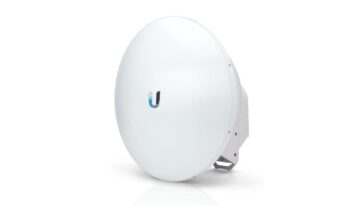When building a long-range wireless bridge or extending your network across buildings, Ubiquiti’s NanoStation series is among the top choices. But which model should you choose NSM5 or NSM2? Both are high-performance outdoor CPE devices, yet they serve different purposes depending on your environment and bandwidth needs.
Let’s break down the differences to help you decide which NanoStation suits your setup in New Zealand.
Quick Comparison Table
| Feature | NSM5 (NanoStation5) | NSM2 (NanoStationM2) |
|---|---|---|
| Frequency | 5 GHz | 2.4 GHz |
| Antenna Gain | 14.6 – 16.1 dBi | 10.4 – 11.2 dBi |
| Max Throughput | Higher capacity | Moderate |
| Interference Resistance | Strong (less crowded band) | Moderate (more interference in 2.4GHz) |
| Ideal Range | Long-range, point-to-point | Mid-range, multi-point |
| Enclosure | Outdoor UV stabilized | Outdoor UV stabilized |
| Operating Temp | -30°C to 75°C | -30°C to 75°C |
| PoE Support | Yes (24V Passive) | Yes (24V Passive) |
| Ethernet Ports | 2 | 1 |
| Applications | Building-to-building links, rural internet | Local wireless extension, short bridges |
1. Frequency Band & Interference
- NSM5 runs on the 5GHz frequency, which is less congested and offers higher data capacity ideal for high-performance point-to-point connections across long distances.
- NSM2 operates on the 2.4GHz band, which offers better penetration through obstacles but is more prone to interference from other Wi-Fi devices.
Verdict: Choose NSM5 for cleaner spectrum and better speeds.
2. Use Case in New Zealand Environments
- NSM5 is perfect for rural New Zealand, connecting farms, schools, or businesses where fiber isn’t available. It’s commonly used by WISPs and in video surveillance links.
- NSM2 works well in urban or semi-urban setups where distances are shorter and signal obstruction is more common.
Verdict: NSM5 is more suitable for long-distance or interference-sensitive NZ applications.
3. Performance & Capacity
- The NSM5 supports higher antenna gain and faster throughput, making it better for video streaming, VoIP, or transferring large data sets.
- The NSM2 provides reliable performance for standard connectivity but may face limitations under heavy bandwidth loads.
Verdict: Go with NSM5 if performance matters.
4. Hardware Differences
- NSM5 has a faster processor (560 MHz vs 400 MHz), more RAM (64MB vs 32MB), and dual Ethernet ports (vs a single port on NSM2).
- NSM2 is simpler but still effective for budget-conscious users.
Verdict: NSM5 wins on power and expandability.
Final Recommendation
| Choose NSM5 if: | Choose NSM2 if: |
|---|---|
| You need long-range wireless bridging | You need indoor/outdoor local coverage |
| You’re deploying in rural NZ or remote sites | You’re working in small to mid-sized spaces |
| You require higher speeds and lower latency | You’re on a budget and need basic performance |
| You want lower interference and dual-port PoE | You’re connecting a single device or area |
FAQs
Which is better for long-distance wireless NSM5 or NSM2?
NSM5 is better for long-distance wireless due to its higher gain antenna and 5GHz operation, which supports faster speeds and lower interference.
Can I use NSM2 and NSM5 together?
No, they operate on different frequencies (2.4GHz vs 5GHz) and cannot link directly. You should use matching models for each wireless end.
Is NSM5 worth the extra cost?
Yes, especially if you need a reliable long-range connection in rural NZ or are streaming high-bandwidth data like video surveillance.
Which is better for a home-to-shed connection on a lifestyle block?
If there’s line of sight, the NSM5 is best for long-range reliability. NSM2 can work if the distance is short and interference isn’t a major concern.



 No products in the cart.
No products in the cart.